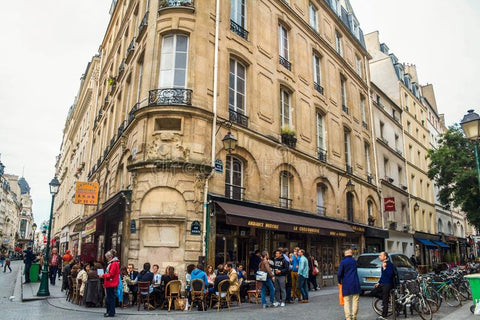As restaurants take over sidewalks to provide pandemic-safe dining, people with disabilities encounter barriers.
By Erika Mailman
August 23, 2020 When New York began allowing outdoor activities in June, Emily Ladau, 29, ventured out in her Long Island town of West Babylon after long months of staying inside because of the novel coronavirus. But her moment in the sun was marred — as a wheelchair user, she found that restaurants spilling over onto the sidewalk blocked her path.
When New York began allowing outdoor activities in June, Emily Ladau, 29, ventured out in her Long Island town of West Babylon after long months of staying inside because of the novel coronavirus. But her moment in the sun was marred — as a wheelchair user, she found that restaurants spilling over onto the sidewalk blocked her path.
“Throughout the whole main street,” of nearby Bay Shore, she says, “I couldn’t be on the sidewalk at all.”
Many restaurants have added sidewalk seating during the pandemic to take advantage of the open air when indoor dining is considered risky because of less ventilation and difficulty in following Centers for Disease Control and Prevention guidelines to keep people at least six feet apart.
Doing so, however, may put up barriers for people with disabilities and come into conflict with the Americans With Disabilities Act. The ADA requires that sidewalk width must be a minimum of 36 inches for wheelchair access.
“It’s important to acknowledge that this is small compared to other issues the disabled community is facing in terms of access to care, but I also want to stress that we can’t forget or ignore the disabled community as we’re reopening,” she says.
That day in June, her able-bodied boyfriend moved decorative planters, tables, and chairs out of her way.
In front of one restaurant, the owner came over to pull leaves and branches of a sidewalk tree aside. “I was like, ‘That’s not what’s in my way,’ ” Ladau says. Not only that, the man was standing too close and wasn’t wearing a mask.
Many cities have drawn up new guidelines to help restaurateurs keep sidewalks ADA compliant. San Francisco’s reopening guidance for outdoor dining lists a multitude of requirements including “Avoid blocking anyone’s ability to pass safely, including avoiding blocking ADA-compliant sidewalk access.”
The city’s Shared Spaces program, which permits temporary use of sidewalks during the pandemic, allows restaurants to extend seating into the street by constructing what’s called a parklet.
“The parklets have been a godsend to restaurants, in many cases meaning the difference between being open or not,” says Patricia Dedekian, project manager for a Mission District restaurant named Curio. “Restaurants are being very creative in their parklet designs. Most go beyond just creating a platform with railings. You see them with plants, string lights, and art. People love sitting in them and people watching.”
The city’s guidelines have kept restaurants aware of their responsibilities, she says.
“I will say this about accessibility,” Dedekian says. “If it weren’t for the city regulating it so carefully, it would be really tempting for restaurants to take as much sidewalk space as possible. It’s hard to make a go of it with so few seats, so anywhere some extra table space can be squeezed in is helpful.”
Not far from the Empire State Building in New York, Hangawi restaurant takes part in the city’s Open Streets Program, which closes selected streets on weekends to allow dining in the street. Mark Choi, 28-year-old son of the restaurant’s owners, says there’s an eight-foot gap between their sidewalk seating and street seating that ensures space for accessibility.
“We had our carpenter come out and do a wooden platform with a triangular block underneath,” he says, which creates a ramp from the sidewalk to the street. “It’s kind of seamless. It’s covered with carpet and gives a green kind of vibe even though it’s fake. You can’t tell there’s an elevation difference between the sidewalk and the roadway.”
In Decatur, Ga., the Deer and the Dove restaurant is operating with a scattering of tables on the sidewalk. “In the front of the restaurant we have a wheelchair ramp, so we keep the tables away from that,” says chef Terry Koval, 44, who owns the restaurant with his wife, Jenn.
The sidewalk is a “good 12 feet,” and so it’s easy to keep the five outdoor tables six feet apart, he says, and keep a cleared six-foot area on the street side.
In Portland, Maine, state guidelines require that tables and guests be six feet apart. At the Portland Hunt + Alpine Club, owners Andrew M. Volk, 36, and his wife, Briana, decided to reopen in early July. Their constructed platform takes up parking spaces in front of the restaurant.
“We made sure it was level to the sidewalk and accessible to everyone,” says Andrew.
But strong regulations aren’t always enough. He has noticed other businesses aren’t in compliance — some created dining areas that require steps.
“As a business owner in a small city, I don’t always find that criticism from a fellow restaurant owner is well-received,” he says. “In general, I’m disinclined to be as collegial with those business owners.”
Haben Girma, 32, a disability justice lawyer and author, points out that this issue is arising in the summer that marks the 30th anniversary of the ADA. She says the act “prohibits places of public accommodation, such as restaurants, from discriminating against disabled people.” She was one of the attorneys who represented the plaintiffs in Ochoa v. City of Long Beach, one of many cases advocates have used to remove sidewalk barriers.
“Today’s widespread ableism frustrates disabled people,” she says. “It’s ableism, not our disabilities, that limits our access to sidewalks.”

